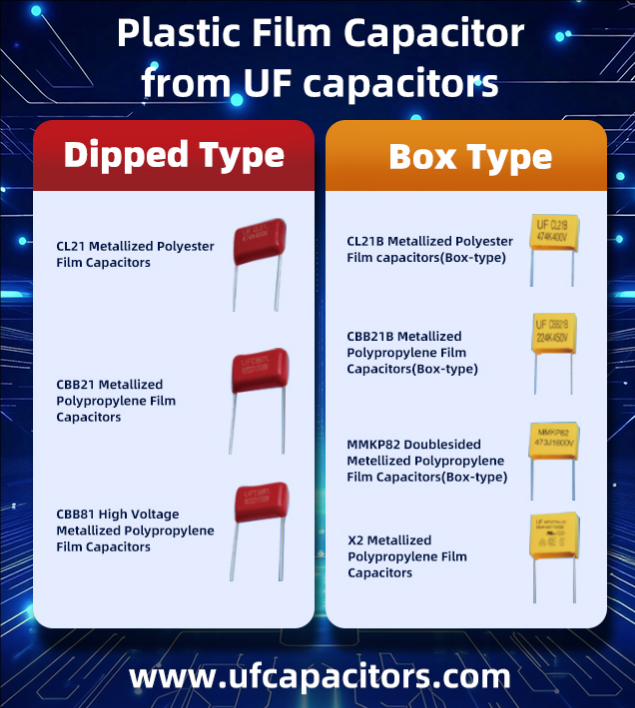Film capacitors are essential electronic components widely used in various industries due to their excellent performance. Unlike ceramic capacitors and electrolytic capacitors, they offer unique advantages in stability, temperature resistance, and lifespan. This article explores the key application scenarios of film capacitors, the specific types used in each field, and their comparative strengths and weaknesses against other capacitor types.

Power electronics systems, such as inverters, converters, and power supplies, rely heavily on film capacitors for energy storage and voltage regulation.
- Inverters for Renewable Energy: Solar and wind power inverters require capacitors to handle high AC voltages and frequent charge-discharge cycles. Polypropylene (PP) film capacitors are preferred here due to their low dielectric loss, high insulation resistance, and ability to operate at temperatures up to 105°C. They outperform ceramic capacitors, which suffer from voltage derating issues, and electrolytic capacitors, which have shorter lifespans in high-temperature environments.
- Motor Drives: Industrial motor drives use metallized polypropylene capacitors for snubber circuits, which protect semiconductors from voltage spikes. Their self-healing property (the ability to repair small dielectric breakdowns) ensures reliability, a feature lacking in ceramic capacitors that can fail catastrophically under stress.
Film capacitors play a supporting role in consumer devices, where space and stability are critical.
- Audio Equipment: High-end speakers, amplifiers, and home theaters use polyester (PET) film capacitors in crossover networks to separate audio frequencies. PET capacitors offer low distortion and stable capacitance over a wide frequency range, ensuring clear sound reproduction. In contrast, ceramic capacitors may introduce audible noise due to piezoelectric effects, while electrolytic capacitors degrade over time, affecting audio quality.
- Household Appliances: Microwaves, air conditioners, and washing machines use film capacitors in power factor correction (PFC) circuits. Metallized PP capacitors are ideal here for their high current handling capacity and resistance to humidity, unlike electrolytic capacitors that are prone to leakage in moist environments.
Modern vehicles, especially electric vehicles (EVs) and hybrids, demand capacitors that can withstand harsh conditions like vibration, temperature fluctuations, and high voltages.
- EV Power Systems: Film capacitors are used in EV inverters and battery management systems (BMS) to stabilize voltage and filter noise. High-temperature-resistant PP capacitors with flame-retardant casings meet automotive safety standards (e.g., AEC-Q200), ensuring operation in temperatures ranging from -40°C to 125°C. Ceramic capacitors often struggle with capacitance drift under temperature changes, while electrolytic capacitors fail quickly in the high-heat engine bay.
- ADAS and Infotainment: Advanced driver-assistance systems (ADAS) and in-car infotainment use small-sized PET film capacitors for signal filtering. Their low ESR (Equivalent Series Resistance) and stable performance under vibration make them more reliable than ceramic capacitors in sensitive electronic modules.
Industrial control systems, robotics, and factory automation depend on film capacitors for precise timing and voltage regulation.
- PLCs and Sensors: Programmable logic controllers (PLCs) use film capacitors in timing circuits and power supplies. Polyester capacitors provide consistent capacitance over long periods, ensuring accurate control signals. Ceramic capacitors may exhibit capacitance loss under DC bias, while electrolytic capacitors’ limited lifespan (typically 2,000–5,000 hours) increases maintenance costs in industrial settings.
- Welding Equipment: High-power welding machines use large film capacitors for energy storage. Metallized polypropylene capacitors with high ripple current ratings handle the sudden energy release required for welding, outperforming electrolytic capacitors that cannot withstand such high current surges.
Aerospace and defense applications require capacitors with zero failure tolerance, making film capacitors the top choice.
- Avionics Systems: Aircraft navigation and communication systems use hermetically sealed film capacitors to resist extreme pressure and temperature changes at high altitudes. Polyimide film capacitors, with their ability to operate at temperatures up to 200°C, outperform both ceramic and electrolytic capacitors, which fail under such harsh conditions.
- Military Equipment: Radar systems and missile guidance systems rely on film capacitors for pulse energy storage. Their radiation resistance and long shelf life (up to 20 years) ensure functionality in long-term missions, a capability unmatched by electrolytic capacitors with limited storage life.
Comparative Advantages and Disadvantages
Capacitor Type Advantages Disadvantages
Film Capacitors High stability, self-healing, long lifespan, low distortion Larger size, higher cost than ceramic capacitors
Ceramic Capacitors Small size, low cost, high frequency performance Piezoelectric noise, capacitance drift, voltage derating
Electrolytic Capacitors High capacitance density, low cost for large values Short lifespan, sensitive to temperature and humidity, leakage risk
Film capacitors, with their diverse types (PP, PET, polyimide) and superior properties, are indispensable in power electronics, automotive, consumer electronics, and critical industries like aerospace. Their self-healing ability, temperature resistance, and long lifespan make them a better choice than ceramic or electrolytic capacitors in scenarios requiring reliability and stability. As technology advances, film capacitors will continue to evolve, supporting innovation in renewable energy, EVs, and smart manufacturing. Whether in everyday appliances or cutting-edge aerospace systems, film capacitors remain a cornerstone of modern electronics.
UF capacitors produces high quality film capacitors to replace tier-1 brands such as Vishay , Kemet, Pilkor, Panasonic, TDK/EPCOS etc to cost down for you. Kindly send RFQ to connie@topdiode.com for PIN to PIN replacement for quotation in free. Thanks